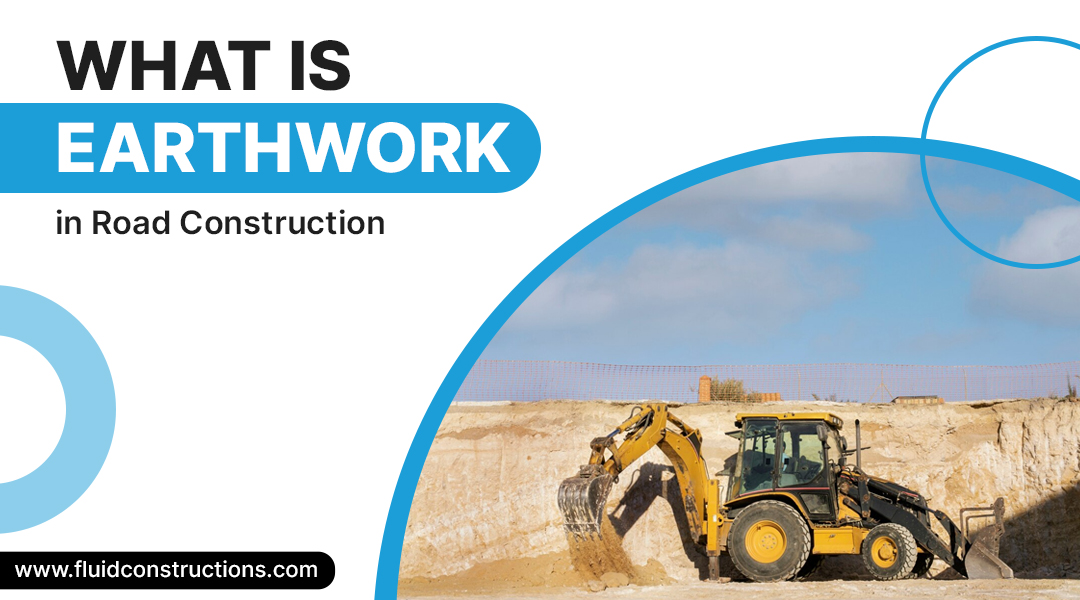
What is Earthwork in Road Construction
Earthwork means moving a portion of the earth’s surface from one location to another. Erecting a building or a structure on the ground requires digging and removing the earth to create a strong foundation bed. But what is earthwork in road construction, and how important is that? Read below for an overview of earthworks in road construction.
What are earthworks?
Earthworks in road construction involve preparing the ground for the construction of highways. Digging, filling, grading, and compacting are some of the procedures used to provide a stable surface suitable for serving as a road or highway foundation.
Excavations, embankments, and other related tasks, including foundations, drainage, stabilization and reinforcement, environmental considerations, and instrumentation, are all considered earthworks in the context of building roads. The phrase “earthwork” refers to any material that is dug out and piled into roadway embankments, including rock, dirt, gravel, and other natural and artificial materials like trash.
Large equipment, such as graders, bulldozers, and dump trucks, are used to transport materials around the roadway site as needed during the project’s duration.
The Different Phases of Earthwork
Earthwork for road construction typically involves several different phases, such as:
- Site Preparation
- Cleaning and Grubbing
- Excavation
- Embankment filling
These must be completed before the road construction work can begin.
Site Preparation
This includes grading the land and testing the soil to make sure it is appropriate for building. The CBR test, specific gravity, moisture content measurement, and soil particle size distribution categorization are typical soil tests used in road building. Every sample that is taken in order to determine the moisture content and particle size should undergo laboratory testing.
Clearing and Grubbing
This stage involves removal of vegetation from the land (clearing). A root rake or similar equipment is used to remove roots that remain in the soil (grubbing).
Backfilling holes and trenches created by tree removal, stump removal, girth branch removal, structure removal, and obstruction clearance are also parts of the clearing and grubbing phase.
Excavation
The construction site must be leveled and free of obstructions. Excavation ensures getting rid of obstacles like rocks, shrubs, and waste and leveling the construction site. By doing this, it is guaranteed that the foundation and other structural elements will be built on solid ground.
Excavation involves the removal of large quantities of soil using heavy equipment such as bulldozers and excavators.
Afterwards, compaction and stabilization measures can be taken to ensure that the ground remains strong enough to support any building on top.
Embankment Filling
A roadway (or railway) embankment is a section of earthen material that has been laid and compacted to raise the level above the level of the surrounding ground surface. A fill is a quantity of earthy material used to fill a depression or hole that has been pressed down and compacted. Although gravel, rock, or crushed pavement material can also be used, soil is typically used to build embankments and fills.
How to calculate the quantity of earthwork?
Earthwork calculations are one of the most significant aspects of construction. It is vital to calculate the size and volume of earthwork to limit the cost of total construction by balancing the cut and fill of soil on the site. In road construction, proper earthwork measurement is required to ensure a level surface and to provide superelevation or banking.
The following reasons signify the importance of earthwork calculation:
- Once the charting and final plan of a geographical region has been completed, the surveyor must determine its area.
- The plotted region does not have to be a regular shape, such as a rectangle or trapezium, although it will almost certainly be irregular.
- Calculating areas and related volumes allows us to determine the amount of earthwork required for filling or cutting, constructing embankments for roads and railroads, determining the capacity of a dam reservoir, calculating the loss of water due to evaporation from a reservoir, and so on.
Calculation of Area
The most common tool for calculating an area is a planimeter. However, different rules and mathematical formulas, as stated below, can be used to calculate area.
- Mid-Ordinate Rule
- Average Ordinate Rule
- Trapezoidal Method
- Simpson’s One-Third Rule
Calculation of Volume
The volume of earthwork is all that matters when discussing the Earthwork Calculation method. There are two ways to figure out volume:
- Trapezoidal Method
- Prismoidal Method
Earthworks challenges and how to prevent them
Just like every other kind of construction endeavor, earthwork has its own set of challenges. Making sure the ground is appropriate for the intended use and activity while also ensuring everyone’s safety is the major difficulty. Experienced contractors should be employed to inspect the site and provide advice on what needs to be done to achieve a good conclusion in order to avoid any issues. Furthermore, it is vital to utilize appropriate instruments and equipment for every phase of the procedure, such as bulldozers and soil compaction machines.
Advice for Getting the Most of Your Investment in Earthworks
Making the most of your investment is crucial when it comes to earthworks in road construction. To do this, think about working with an expert contractor who can offer guidance on the best course of action and produce high-quality work. Additionally, before starting any excavation or compaction work, make sure you are familiar with the type and condition of the soil. Ultimately, it is usually advantageous to investigate and contrast various contractors or suppliers to identify one that does excellent work at reasonable costs.
